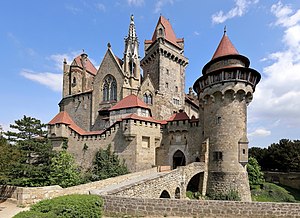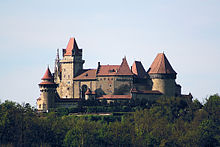Kreuzenstein Castle
| Kreuzenstein Castle | ||
|---|---|---|
|
West view of Kreuzenstein Castle |
||
| Creation time : | around 1100 to 1200 | |
| Castle type : | Hilltop castle | |
| Conservation status: | largely rebuilt in the 19th century | |
| Standing position : | Count | |
| Place: | Leobendorf | |
| Geographical location | 48 ° 22 ′ 45 " N , 16 ° 18 ′ 32" E | |
| Height: | 266 m above sea level A. | |
|
|
||
The Kreuzenstein Castle is a Schau- or museum castle in the market town of Leoben village in the district of Korneuburg in Lower Austria .
The originally medieval castle complex was destroyed in the course of the Thirty Years War and then largely removed as building material. Under Count Johann Nepomuk Wilczek , the castle was rebuilt from 1874 to 1906 as a museum for its extensive art collections. The Schauburg, which was created in this way, is now a popular tourist destination north of Vienna , supplemented by numerous reused medieval components and after the fire damage of 1915 and the war damage of 1945 had been partially removed .
location
The Höhenburg is located north of the Danube on a hill in the Rohrwald , directly north above the village of Leobendorf and at the same time between the cities of Korneuburg and Stockerau . The altitude is 266 m above sea level. A. , the height above the Danube about 100 m.
The Burgberg stands not far from the Danube Bend at the Wiener Pforte , so that it allows a wide view of the course of the river and the Korneuburg Basin in front of it. About opposite, on the south bank of the Danube, lies Greifenstein Castle .
history
The medieval castle of the Habsburgs
Like most castles in Lower Austria, the origins of Kreuzenstein Castle go back to the 12th century. Built by the Formbachers , it came into the possession of the Counts of Wasserburg through marriage. The castle came into the possession of the Habsburgs via Ottokar II of Bohemia in 1278 .
The Anabaptist preacher Balthasar Hubmaier , arrested on the pretext of the uprising in Nikolsburg ( Moravia ), was transferred to Kreuzenstein Castle in July 1527 and interrogated there. Since he refused to withdraw, he was sentenced to death and burned in Vienna on March 10, 1528.
The original Kreuzenstein Castle had never been conquered until the Thirty Years' War in 1645. But when the Swedes occupied large parts of Lower Austria in the final phase of the war and advanced as far as Vienna, on April 4, 1645, Colonel Lukas Spicker, the commanding officer of Kreuzenstein Castle and Korneuburg Fortress, was requested to hand over both defensive sites. In view of the small number of troops he had at his disposal, Spicker immediately complied with the request and handed the castle and town over to the Swedish troops commanded by Field Marshal Lennart Torstensson on April 5 without a fight . When the main Swedish armed forces began to withdraw to Moravia at the end of September 1645, Torstensson ordered the Kreuzenstein Castle to be blown up, which was carried out in three - some sources also speak of four - places. After that, the castle was just a ruin, the remains of the wall used by the farmers in the area as a source of materials for building projects.
Reconstruction under the Counts of Wilczek
The castle ruins came into the possession of the Counts Wilczek in the 18th century, who had made a large fortune through their coal mines in Silesia . Count Johann Nepomuk Wilczek , who became known as a polar explorer, began in 1874 to gradually build a show castle at the same place, which in appearance in no way corresponds to the former castle ("Romanesque-Gothic model castle"), but the remains of the medieval castle (mainly parts the curtain wall , hull of the east tower and parts of the chapel ) in the design. With a little practiced eye, the medieval building remains can be easily distinguished from the masonry of the components from the 19th century. The architect Carl Gangolf Kayser was in charge of construction management until his death in 1895 , followed by his successor Humbert Walcher von Molthein and the artist Egon Rheinberger . A family crypt was built under the chapel. Wilczek himself has also found his final resting place here. The entire castle was built on the one hand from or on the remains of the medieval castle, on the other hand from a large number of original components - so-called Spolia - that Wilczek had collected from all over Europe. In addition, the castle was equipped with a large collection of medieval furnishings and artifacts , e.g. B. with one of the oldest surviving medieval slingshots that was bought from the Hohensalzburg Fortress . The work lasted 30 years - at the official reopening on June 6, 1906, the German Emperor Wilhelm II was present. In 1915 the archive and library tracts burned down after a lightning strike .
Kreuzenstein Castle today
During the fighting in 1945 between the German Wehrmacht and the Red Army , some of the rooms were badly damaged and many items from the collection were stolen. Many of the manuscripts in the Wilczek Collection are now in the Austrian National Library .
Today the castle is a popular excursion destination in the Vienna area and can be visited as a museum. Every year at the end of June the classic castle serenade took place in the castle courtyard. However, at the request of the lord of the castle, these no longer exist. Also located on the hill the Adlerwarte Kreuzenstein which also public raptor look organized, and the redesigned Burgtaverne Kreuzenstein which until 2019 was a resurgence of medieval tavern, 2013. Kreuzenstein Castle has been the titular seat of the Lazarus Union since June 2013 .
architecture
Exterior description
Kreuzenstein Castle is a neo-romantic building, intended as a “model castle ”, which was laid out in a ring around a courtyard above the floor plan of the medieval castle. It has towers of different heights, residential buildings, a moat and a defensive wall. The effect of the castle is determined by the tracts of different heights and the numerous towers with hipped roofs . The castle was built entirely out of stone, and some of the reused building materials from the Middle Ages can also be recognized. The western front of the castle is built narrow and has a polygonal northwest tower. This is followed by the gable front of the chapel with tracery windows . Below is a crucifix from around 1520. On the side is a polygonal bell tower, which is decorated with crabs and pinnacles . At the top of the bell tower is a bronze figure of St. Michael from the 16th century. The wings, sword and shield were added in the 19th century.
The western entrance runs over a high brick arch bridge and a drawbridge to the gatehouse. The gatehouse is provided with a pitch bay. Then there is the kennel.
The castle as a film set
The fact that Kreuzenstein is a so-called Schauburg has repeatedly drawn filmmakers' attention to this gem. Films and TV series have been and are being produced on Kreuzenstein for over 100 years. One of the earliest examples is Das Mirakel , partially realized here by Max Reinhardt in 1912 . Later the Austrian director Willi Forst shot some scenes of his homeland film Kaiserjäger here in 1956 , as did Franz Antel 1957 Four Girls from the Wachau , Michael Curtiz 1960 Princess Olympia (based on "Olympia" by Ferenc Molnar ), and Adrian Hoven 1967 the horror film Im Schloß der bloutigen Desire .
In the 1970s, other horror films followed (e.g. the German vampire comedy Bitten is only at night in 1970 - the happening of the vampires by Freddie Francis and in 1972 the Italian horror film Baron Blood by Mario Bava ), as well as the soft porn flick Die Shockburg - When the chastity belts rattle at night by Franz Marischka .
In 1979 parts of the film The Secret of the Iron Mask (with Beau Bridges , Rex Harrison , Sylvia Kristel ) and in 1985 parts of the German film Die Einsteiger with Thomas Gottschalk and Mike Krüger at the castle were produced. The Disney film The Three Musketeers (1993) was partly shot in the castle.
In 2004 part of the film Shadow of the Sword was filmed here and in 2006 a music DVD by the German Gregorian music group Gregorian was recorded. Two Tom Turbo episodes (2003/2006) were also set in the castle. In 2008, Kreuzenstein Castle was used again as a film set for the 2011 American production The Last Knight Templar with Nicolas Cage .
In the German-Canadian multi-part television film Die Säulen der Erde , Ken Follett 's novel of the same name served as a template and the castle as a backdrop. Filming started here in 2009 with Rufus Sewell , Matthew Macfadyen , Ian McShane in the main role and Donald Sutherland in a supporting role.
In 2014, Burg Kreuzenstein acted as the backdrop for the reality show The Quest for the American television station ABC .
In 2015, parts of the ORF / ZDF television film Maximilian - The Game of Power and Love and, at the beginning of 2017, parts of the children's film Witch Lilli saves Christmas were shot at the castle.
In 2019, some scenes from the Netflix series The Witcher were filmed there.
See also
literature
- Johann Paukert: Kreuzenstein - historical-topographical sketch . Vienna 1904.
- Alfred Ritter Walcher von Molthein (ed.): Castle Kreuzenstein on the Danube . Vienna 1914 (extensive table with some views of the castle ruins before reconstruction).
- Andreas Nierhaus: Kreuzenstein. The medieval castle as a construction of modernity . Böhlau, Vienna 2014, ISBN 9783205795575 .
Web links
- Entry on Kreuzenstein in the scientific database " EBIDAT " of the European Castle Institute
- Entry about Burg Kreuzenstein on Lower Austria Burgen online - Institute for Reality Studies of the Middle Ages and the Early Modern Era, University of Salzburg
- Entry for Castle Kreuzenstein in the database of the state's memory of the history of Lower Austria ( Museum Niederösterreich )
- Official homepage of Kreuzenstein Castle
- Kreuzenstein Castle in the Werbeka Netshop
Individual evidence
- ^ Institute for Realienkunde of the Middle Ages and the Early Modern Era : Kreuzenstein ; accessed on April 26, 2018.
- ^ Peter Broucek: The Swedish campaign to Lower Austria 1645/46 (= military historical series, issue 7). Österreichischer Bundesverlag Ges.mbH, 3rd edition, Vienna 1989, ISBN 3-215-01654-0 , pp. 10 and 21.
- ↑ Entry about Kreuzenstein on Burgen-Austria
- ^ Nikolaus Schaffer: On the history of the Salzburg artillery in 1800 . In: Mitteilungen der Gesellschaft für Salzburger Landeskunde , Volume 125, 1985, p. 525.
- ↑ Burg Kreuzenstein is the titular seat of the Lazarus Union. ( Memento of the original from October 6, 2014 in the Internet Archive ) Info: The archive link was automatically inserted and not yet checked. Please check the original and archive link according to the instructions and then remove this notice.
- ↑ Sophia Felbermair: Hero search at Castle Kreuzenstein. In: orf.at. July 14, 2014, accessed July 26, 2020 .
- ↑ "Maximilian: The Game of Power and Love" (AT): ORF / ZDF production with Niewöhner, Theret, Moretti, Anglade, Karl, Steinhauer and many more . OTS notification dated August 6, 2015, accessed February 1, 2017.
- ↑ Lilli the witch saves Christmas - filming at Kreuzenstein Castle . Retrieved October 7, 2017.





